[Economic Significance] Diptera includes flies, mosquitoes, gnats, midges and flies, with only one pair of developed forewings. Their living habits vary widely and they are extremely adaptable. Some species are important pests or beneficial insects in agricultural and forestry production, and some species are famous Sanitary pests harm the health of humans and animals, spread diseases, and cause plagues.
[Identification points] The mouthparts are sucking or sucking, with only one pair of well-developed membranous forewings, and the hind wings are specialized as balance sticks. A few species are wingless, and the tarsus has 5 segments.
[Species and Distribution] There are about 100,000 known species in the world, distributed all over the world. About 5,000 species have been recorded in my country.
The characteristics of this order can be summarized as follows: mosquitoes, midges, flies, Diptera, hind wings balanced with five-segmented tarsus; mouthparts for piercing and sucking or licking, and the larvae have no legs or heads.
[Classification system and introduction to important families] Diptera can be divided into 2-3 suborders based on morphological and biological characteristics.
I. Nematocera
Adult insects are small and slender. The antennae are filamentous, generally longer than the head and thorax combined, with 6-18 segments, and some can reach 40 segments. Most of the wings have no central chamber.
(1) Tipulidae
Medium to large size, like a mosquito, but does not bite. The body is slender, the legs are long and easy to break. There is a "V" shaped groove on the mid-thorax and back plate.
(2) Culicidae
The body is small. The male antennae are hairy and the beak is slender and extends forward. The wings are narrow and long, with rounded top corners. The most important feature is the scales on the wing edges and veins.
Most adult mosquitoes are active at dusk and night. Male mosquitoes feed on nectar and other plant matter, while female mosquitoes only suck the blood of certain animals or the blood of humans and animals. Non-pathogenic species pierce and suck blood, causing direct blood loss, and their secretions can also cause itching and swelling, which can lead to dermatitis or abscesses. Some species can transmit about 150 dangerous diseases to humans and animals, such as malaria, encephalitis, and yellow fever. There are more than 3,200 known species in the world, and more than 200 species have been recorded in my country. Common pathogenic vectors include Anopheles sinensis Wiedemann and others.
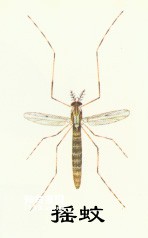
(3) Chironomidae
Weak and small, with short beak-like mouthparts and no function. The chest is large and there is a longitudinal groove on the back of the chest. The legs are long and slender. When resting, they often raise their front legs and shake them constantly, hence the name chironomids. There is a tibial spur and the tarsus is very long. The wings are generally long and narrow, with prominent veins on the front edge, and other veins are not obvious, with only one transverse vein.
(4) Ceratopogonidae
The antennae are longer than the head and thorax and have hairs. The mouthparts are suitable for piercing and sucking, and the beak is short. Wing veins are few. The leg joints are enlarged. There are thorns underneath.
(5) Simuliidae
The compound eyes are large and round, with eyes closed in male insects, and are often divided into upper and lower parts. The wings are broad and hairless, with 2-3 thick longitudinal veins on the front edge, and the remaining veins are not obvious.
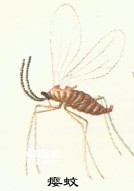
(6) Cecidomyiidae
The body is extremely small, the antennae are beads-shaped, and have whorls of fine hairs. The compound eye is the connecting eye. The wing veins are reduced, with only 3-5 longitudinal veins and no transverse veins.
II. Brachycera
Medium to large, stout. The antennae are short, with 3 segments, and the 3rd segment is often extended or divided into subsegments, or has terminal spines.
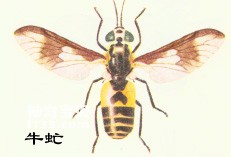
(1) Tabanidae
Medium to large, stout, hairy. The head is large and hemispherical. The tentacles have 3 segments, the 3rd segment is the largest, divided into 4-8 subsegments, and heals into a horn shape. The paw pads and interclaw processes are both flap-shaped.
Adults like to be active in the sun and have strong flying power. They often linger in wetlands and ponds. The males feed on nectar or pollen, and the females suck blood. They stab pachyderms such as cattle and horses or humans with their pincers, and even feed on large pieces of flesh. It can cause severe blood loss and injury, cause wound infection, and spread various zoonotic diseases such as anthrax and trypanosomiasis. There are about 3,500 known species in the world, and there are more than 200 species in my country. Common ones include Tabanus mandarinus Schiner, etc.
(2) Insectivorous flies (family Asilidae)
The body is long or slender, with many fine hairs and stinging hairs. The top of the head is sunken downward between the compound eyes. The tentacles have 3 segments, with 1 stinger at the end. The beak is hard and horn-shaped. The legs are long, with spines between the claws.
Adults have strong flying power. Females have stronger predatory abilities than males and are full of challenges. They are gluttonous and can hunt large wasps, dragonflies and other insects in flight. They also often prey on bees and disturb the apiary. There are more than 5,000 known species in the world, and more than 200 species have been recorded in my country, such as Leptogaster basilaris Coquillett, Cophinopoda chinensis Fabricius, etc.
III. Aristocera (Cyclorrhapha)
The antennae are short, with 3 segments, and there is an antennal awn on the back of the 3rd segment. The larvae are headless, surrounding the pupa, and have an annular ring at the front when they emerge.
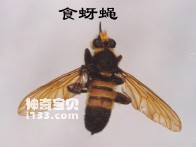
(1) Syrphidae
Small to medium-sized, resembling a bee or wasp in appearance, smooth or soft-haired, often with yellow-orange stripes between blue and black. The wings are large, with transverse veins parallel to the outer edges.
Adults can stay motionless or lunge at high altitudes. They often move between flowers, feed on nectar, pollen or juice, and lay eggs in aphid colonies or in sewage or manure ponds. The larvae prey on aphids, scales, leafhoppers, thrips or small larvae of the order Lepidoptera and Hymenoptera, or feed on humus, feces, carcasses of bees and ants, or harm plants. They are occasionally found in the human intestines, causing myiasis. . There are about 4,000 known species in the world, and about 200 species have been recorded in my country. Common ones include the slender hoverfly Baccha maculata Walker and so on.

(2) Tephritidae (Trypetidae)
Small to medium sized, yellow or brown. The head is large and broad or spherical, and the neck is thin. The wings are broad, usually with foggy brown spots and stripes. The sub-frontal veins bend at right angles to the front edge, and the end of the hip chamber forms an acute angle. The ovipositor is long and protruding, flat and hard, divided into 3 segments.
Adult insects are commonly found among flowers, fruits or leaves. They flap their wings continuously when resting. Phototaxis. The larvae are herbivorous and feed on various organs of plants, causing galls. They are important pests of nuts, citrus, vegetables, Asteraceae and other plants. There are about 3,700 known species in the world, and they are distributed all over the world except the two poles. About 400 species have been recorded in my country. The world-famous pests Ceratitis capitata (Wiedemann) and Rhagoletis pomonella (Walsh) harm a variety of fruits and are listed as foreign quarantine targets in my country.
(3) Drosophilidae
The body is small, yellow, and the compound eyes flash red. The third section of the tentacles is oval or round, and the tentacles are feathery. The anterior margin vein is notched and the submarginal vein (Sc) is degraded. There are more than 1,000 known species in the world. Drosophila melanogaster Meigen is distributed worldwide and is a commonly used experimental material in genetic research.
(4) Muscidae
The antennae are awned at the base of segment 3 and are feather-like. The chest and back have black vertical stripes. They mostly live in residential areas or toilets. Adult worms gather in groups and lick human and livestock feces and food. Some adult worms suck blood, endangering the health of humans and animals, and spreading more than 50 diseases such as cholera, typhoid, and dysentery. The larvae live on feces and decaying organic matter. Common ones in my country include house flies (house flies), Musca domestica vicina Macquart, etc.
(5) Gasterophilidae
Adults resemble bees. The compound eyes are far apart and the beak is underdeveloped. The tentacles shine naked. There is powder on the body and no bristles. The wings are large. The larvae live in the horse's stomach.
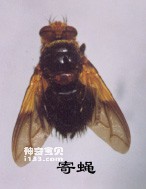
(6) Tachinidae
Similar to flies, but the antennae are bare or slightly hairy. The small scutes behind the back of the thorax are well developed, and there are many thick bristles at the end of the abdomen. Adults are active during the day or gather on flowers. The female lays eggs inside the host or the larvae burrow into the host to feed. Some larvae can cause rapid death of the host. The hosts are mostly Lepidoptera larvae and pupae, Coleoptera larvae and adults, sawflies, etc. There are about 3,000 known species in the world. The beneficial insects used for biological control of agricultural pests in my country include pine caterpillars, Carcelia matsukarehae Shima, Japanese chasing flies, Exorista japonica Townsend, etc., while silkworms, such as Blepharipa zibina (Walker), are domestic and tussah silkworms. important pests.
animal tags: Insects Diptera flies mosquitoes gnats midges
We created this article in conjunction with AI technology, then made sure it was fact-checked and edited by a Animals Top editor.